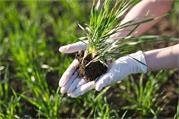I know the farmer who has grown potatoes. Я знаю фермера, который вырастил картофель. (Союзное слово who здесь является подлежащим)
We were not even explained what to do. Нам даже не объяснили, что нужно делать. (Союзное слово what здесь является дополнением)
I am sure the soil will contain more organic matter when the yield of corn is much higher. Я уверен, что почва будет содержать больше органического вещества, когда урожайность кукурузы будет намного выше. (Союзное слово when здесь является обстоятельством времени)
LESSON 19.1 . ROOT CROPS
1 . Study carefully the Grammar Focus section of this unit .
2. Highlight subordinate clauses in the following sentneces. Translate into Russian.
1. If the soil contained more organic matter the yield of corn would be much higher.
2. The rate of sowing may be increased, provided the soil is rich in nutrients.
3. The seeds will not germinate unless the soil temperature is proper.
4. If grown for grain on fertile soil rye is usually less profitable than other cereals.
3. Translate the following complex sentences.
1. The yield the new potato variety produces on our poor soil is rather high.
2. Soils potatoes prefer are well-drained sandy loams supplied with enough nutrients and water.
3. Tubers we use for planting are usually cut into pieces.
4. The depth the tubers are planted at varies with the soil type and the equipment used.
6. It is well known that the soil the root crops require should be fertile and deep.
4. Identify the meaning of the word as and translate the sentences.
1. As root crops are high in sugar and low in protein they do not supply a balanced diet.
2. As plants grow they require more nutrients and water.
3. In order to grow normally crops should absorb such minerals as calcium, magnesium and sulfur.
4. We have to apply much manure as this soil is too low in organic matter.
5. The nature of the soil changes as the proportion of clay particles increases.
5. Highlight correlative conjunctions and translate the sentences.
1. Potatoes are mostly grown in areas where the climate is neither too hot nor too dry.
2. Both cut tubers and whole ones can be used for planting.
6. The yield of corn grain is not so high in our region as it is in the South.
7. Spring wheat removes nitrogen in greater amounts than either potassium or phosphorus.
8. The coarser is the seed the deeper it should be sown.
9. Microelements are as important as primary elements.
Vocabulary Focus

| Handwrite the words and word combinations related to text A and give their Russian equivalents. Check them in the agronomy and soil science dictionaries |
| Abundant, fresh, carrots, radishes, onions, by-product, herbicide, weedkiller, to consume, to value, type, comparatively, as a rule, level, recent, effective, to emerge, pre-emergence application, post-emergence application, mechanization, to facilitate. |

6. Read and translate text A. Highligh complex sentences in the last paragraph and specify conjunctions introducing them.
Text 19A
Root Crops
The common feature of root crops is their fleshy underground storage organ. It is the root that these crops are widely grown for throughout the world both in home gardens and commercially. Compared to cereal and legume seeds, food stored in fleshy roots is watery and less concentrated. That is why root crops are not generally easily stored and transported. Most are abundant in carbohydrates and low in protein and oil and hence are useful “energy foods” but do not by themselves supply a balanced diet.
Some root crops consumed as fresh vegetables such as carrots, radishes, onions, etc. are valued both for their flavour and as sources of energy. Sugar beets have been developed for the extraction of sugar while their by-products are a valuable food for livestock.
Main factors affecting the growth and best development of roots a growing-season temperatures, type of soil with a particular reference to its water content, drainage, acidity and the available nitrogen supply. As far as the temperature is concerned it should be different at different stages of growth. Since the size and quality of the root depend on the development of the foliage, comparatively high temperatures during the seedling stage permit the development of large top. Somewhat lower temperatures after the tops are fully grown will result in the development of large high-quality roots.
As a rule, the best yield of roots are obtained on sandy loams which are not acid and in which the moisture content can be maintained at a reasonable level. With the roots growing underground, a deep seedbed is necessary. When practicable, the land should be plowed in the fall so that it may be worked early in spring. In general the soil recommended is the one that is fertile, deep and of a texture which is easy to work.
In recent years root crop growing has been changed by several new developments. One of them is mechanization which facilitates growing and harvesting roots. Special root drills and mechanical thinners make it possible to eliminate most of hand labour formerly required for root crop production. Weedkillers or herbicides are known to have been developed for controlling weeds in most of the root crops.
They can be applied either before plants emerge or after they appear. The former method is known as pre-emergence while the later as post-emergence application. If used with care, the weedkillers are highly effective in maintaining the soil free of weeds and hence in increasing root crop yields.
Notes to the text
1. compared to – по сравнению с;
2. by themselves – сами по себе;
3. as far as … is concerned – что касается.
Comprehension activities
7. Highlight the sentences with conjunctions introducing subordinate clauses. Translate these sentences into Russian.
1. When the soil is known to be low in organic matter, the growing of green manure crops may be desirable.








